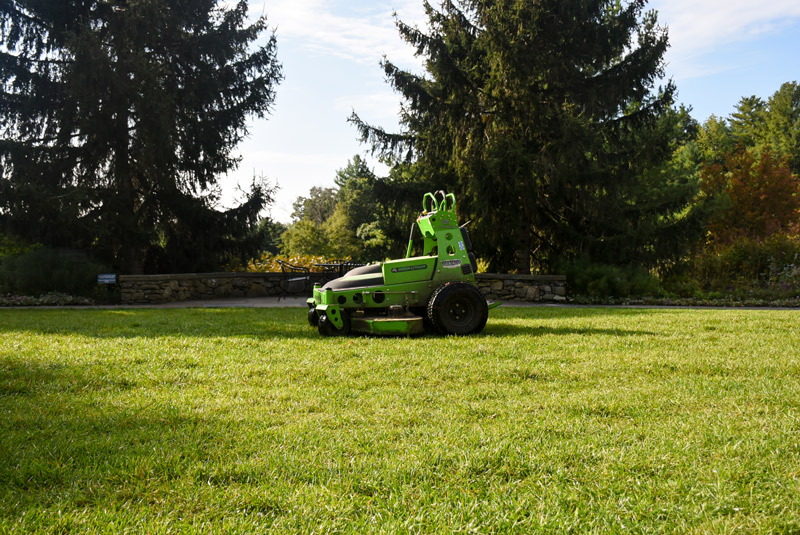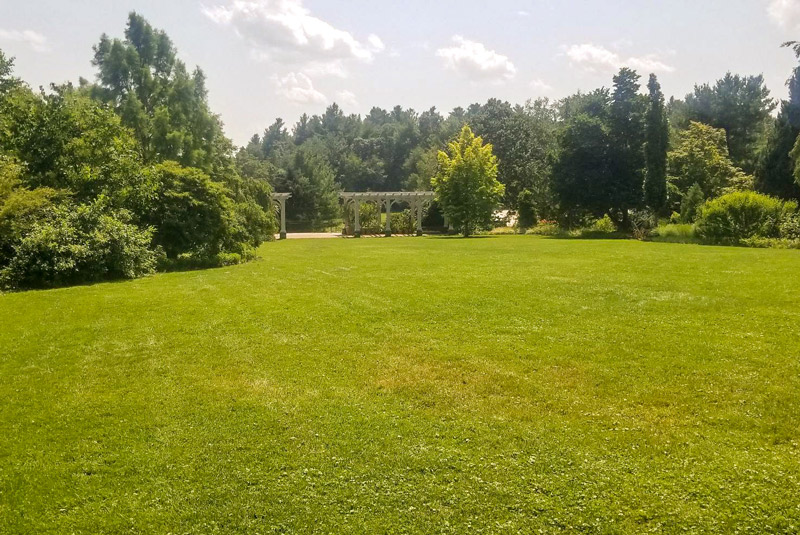It’s 8AM at the Garden. There are no visitors yet. Sprinklers quietly sputter and spray as the voices of volunteers chatting with horticulture staff about morning tasks carry over the Lawn Garden. Then, Robert Graham, New England Botanic Garden’s Land Steward, powers up a bright green mower. Does the peaceful garden picture change?
Yes and no. The truth is, as Robert drives the mower in neat lines across the Lawn Garden, the quiet morning remains relatively undisturbed. That’s because instead of starting up and rumbling along under the power of a four-stroke gas motor, the Mean Green mower Robert uses runs on a battery. Instead of hearing the loud sound of the motor, all you can hear is the swoosh of the mower’s blades.
 “Believe it or not, this mower can get even quieter,” Robert says.
“Believe it or not, this mower can get even quieter,” Robert says.
Roberts’s been with the Garden for over five years. He manages over 130 acres of meadows and woodland areas. Recently, he’s deepened his knowledge of electric landcare equipment to help the Garden reach a major milestone.
This month, New England Botanic Garden celebrates its recognition as the first botanic garden in the country to earn Green Zone certification from the American Green Zone Alliance (AGZA). An AGZA Green Zone is one where routine maintenance is performed with low impact equipment—think electric leaf blowers, chainsaws, string trimmers, and, of course, mowers. Becoming a Green Zone involves completing a structured program of education, training, certification, and metrics reporting all aimed at achieving an enduring transition to cleaner, quieter, more sustainable landscape maintenance practices.
The Garden began its Green Zone journey about three years ago. Robert met Dan Mabe, AGZA’s founder, at a workshop. At the time, the negative health impacts associated with the regular use of gas-powered equipment interested Robert as much as the harmful environmental consequences.
“When you’re operating a gas-powered piece of equipment, like a backpack leaf blower, it’s like you’re walking around with a bunch of small explosions strapped to your back,” Robert says. Vibrations from hand tools pose serious risks such as nerve damage and can have long term consequences for workers in industries that require regular use of these tools. Equipment with two-stroke engines also produce harmful exhaust and damaging levels of noise pollution, not to mention the climate change escalation caused by the continued burning of fossil fuels. Founded in 2013, AGZA works with a nonprofit partner, Quiet Communities, to catalyze sustainable transitions. It implements its Green Zone program nationwide in parks, municipalities, institutions, and businesses.
After the workshop, Robert brought what he learned about AGZA and the idea of becoming a Green Zone to Mark Richardson, New England Botanic Garden’s Director of Horticulture. “Sustainability is baked into the Garden’s strategic plan,” Marks says. “It’s part of our organization’s DNA, so partnering with AGZA and Quiet Communities made sense.”
Key to the Garden’s ongoing electric transition was an in-depth process to determine what products would best suit the needs of the horticulture team and the landscape of the Garden. “Electrical equipment doesn’t always have the same capacity as gas-powered equipment,” Robert says. “The equipment just isn’t one-to-one yet, so the hardest part about transitioning is changing behavior and changing approach. You have to take a step back and figure out how you can manage, not at a lower level, just in a different way.”
 The Garden hopes that by demonstrating electric equipment use across the property and offering guidance to others, more organizations, landscaping professionals, and homeowners will feel they can make the switch, too. With electric equipment technology evolving quickly, the possibility of widespread adoption is here.
The Garden hopes that by demonstrating electric equipment use across the property and offering guidance to others, more organizations, landscaping professionals, and homeowners will feel they can make the switch, too. With electric equipment technology evolving quickly, the possibility of widespread adoption is here.
To date, the Garden has replaced, or begun the process of replacing, its array of gas-powered landscaping tools with battery-powered electric models. We’ve also incorporated a fleet of 11 electric utility carts into our operations. To charge this equipment, we’ll soon install solar panels on the roof of our horticulture barn. An ELF® (Environmental Landscape Footprint) report generated by AGZA and Quiet Communities estimates that these electric transitions will eliminate 50 tons of carbon dioxide emissions annually—the equivalent of planting 2,220 trees, or taking eleven gas-powered cars off the road each year.
For more information, including a wealth of peer-reviewed scientific resources, about the environmental, worker, and community health benefits of transitioning to electric landcare equipment, explore resources shared by our partners, American Geen Zone Alliance and Quiet Communities. Follow them on social to stay tuned as electrification continues its spread across the green industry and beyond. And don’t forget to check back with the Garden for more stories about our exciting sustainable initiatives.
—Liz Nye, New England Botanic Garden, October 2022
